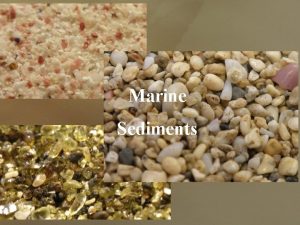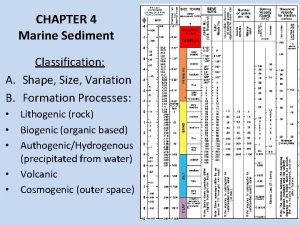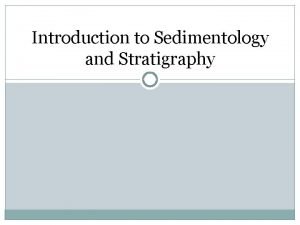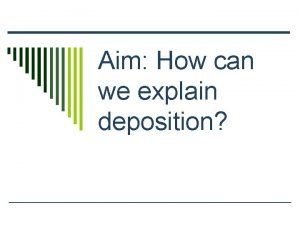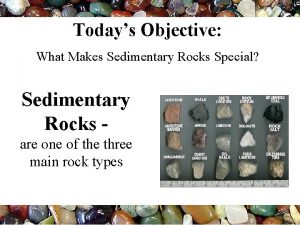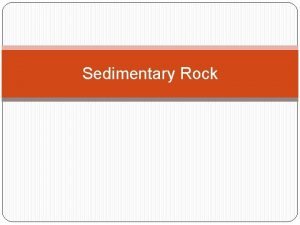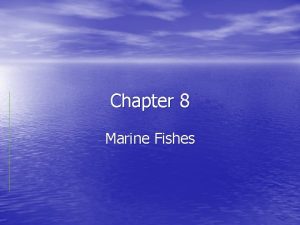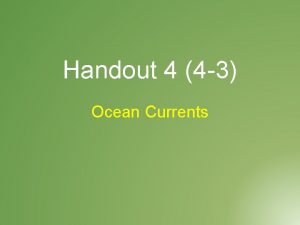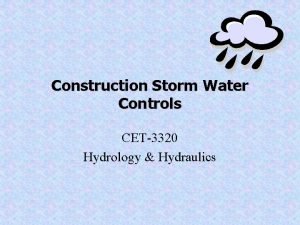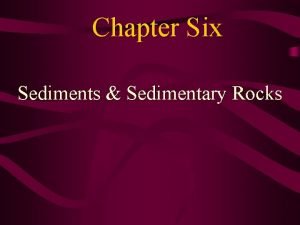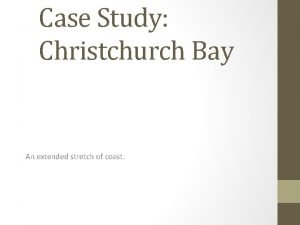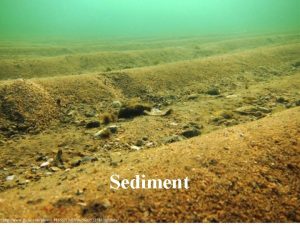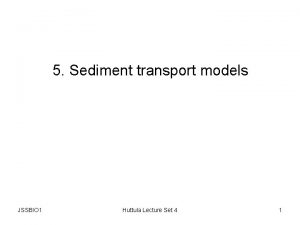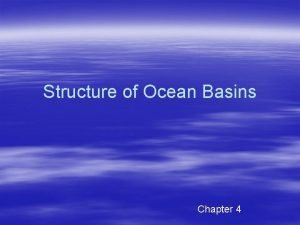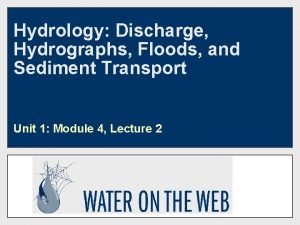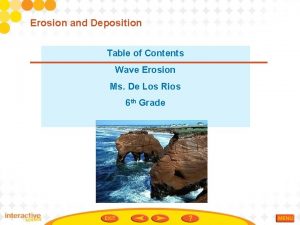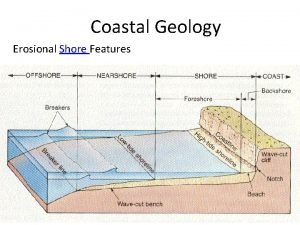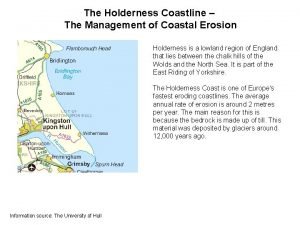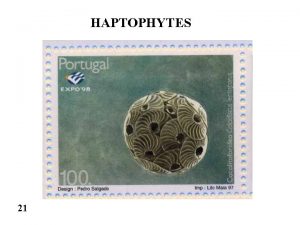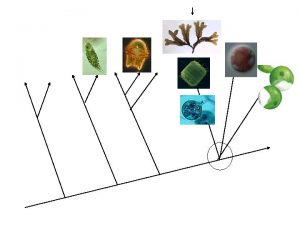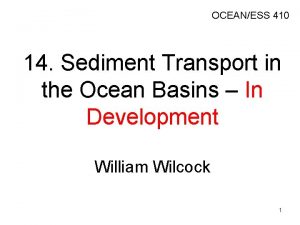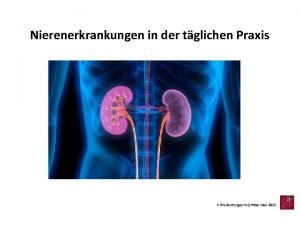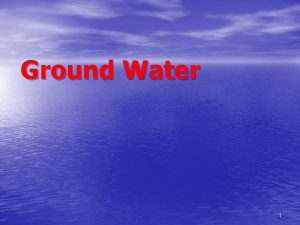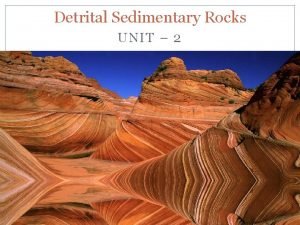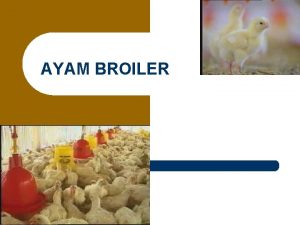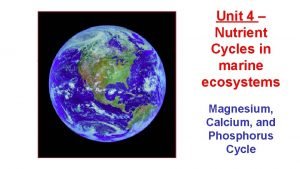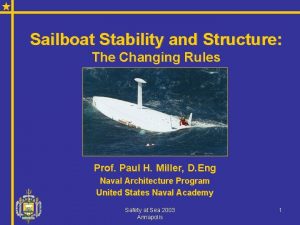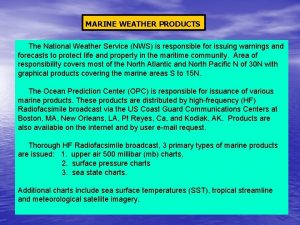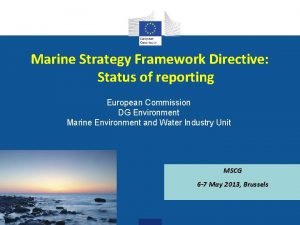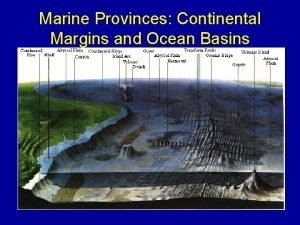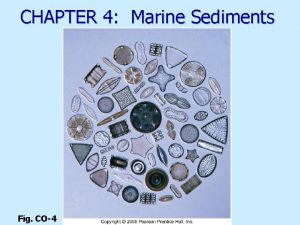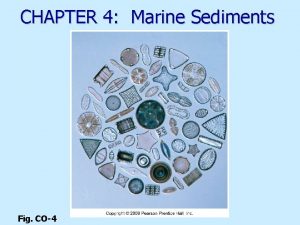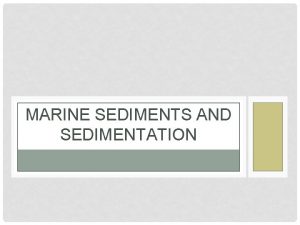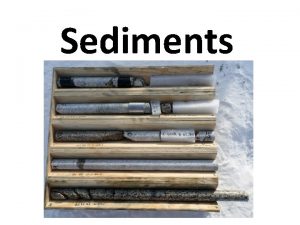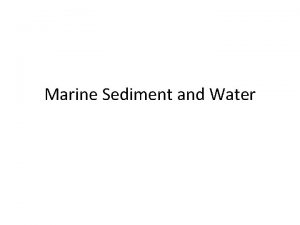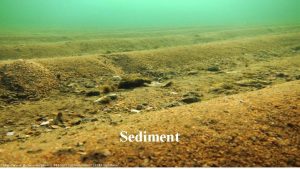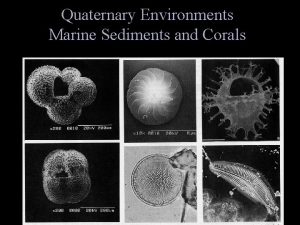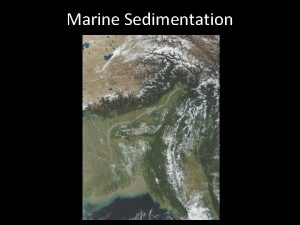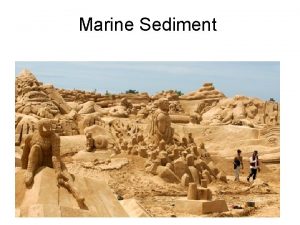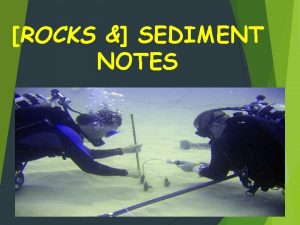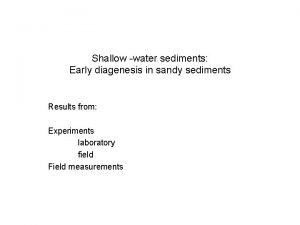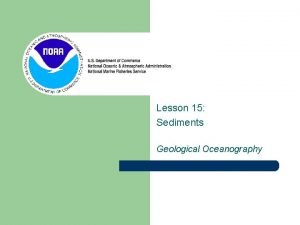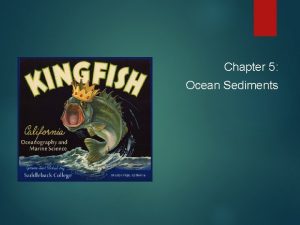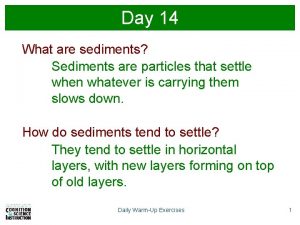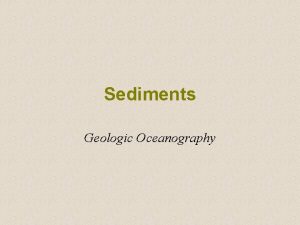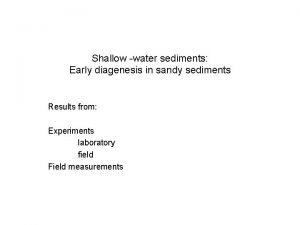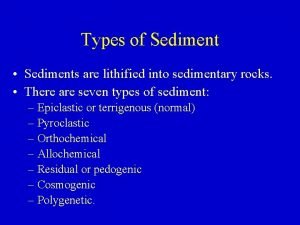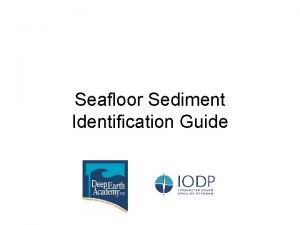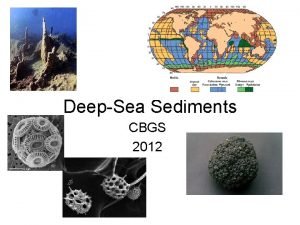Marine Sediments Sediment Classification All sediment classification is


























































- Slides: 58

Marine Sediments

Sediment Classification All sediment classification is based on… Gravel, Sand, Silt, Clay 1. Grain Size 2. Angularity 3. Sorting Roundedness of the grains 4. Composition What minerals or chemicals Distribution of the grain sizes

Grain Size • • Gravel Sand Silt Clay Silt + Clay = Mud

Four Types of Marine Sediments 1. Lithogenous Sediment 2. Biogenous Sediment 3. Hydrogenous Sediment 4. Cosmogenous Sediment

Lithogenous Sediment Origins ~ Weathering of continental rocks Also from volcanoes volcanic ash

Lithogenous Sediment . … e t i n ra g f r z t o e r Composition ~ d ath ua e s we d q o p e n Composed primarily i m h s o la e c b c y of quartz l tho ing i r a or v m a i r nd e l p y is le a ickl t s bo qu u r i c h e l p Quartz d a nt , am ero e n ca nd i t n mi a o C Mica Amphibole Orthoclase

Lithogenous Sediment Texture Wentworth Scale – Grain Size

Lithogenous Sediment Distribution ~ Categorized as either…. Neritic Pelagic Found in deep ocean basins - Finer-grained Found on the continental shelf or shallow water near islands - coarser-grained

Lithogenous Sediment Neritic Sediment Beach Deposits Glacial Deposits Turbidity Deposits – underwater avalanche down the continental slope Continental Shelf Deposits

Lithogenous Sediment Pelagic Sediment – Abyssal Clay 70% clay sized particles Transported by wind or ocean currents Contained oxidized iron red clays


Biogenous Sediment Origins Macroscopic Biogenous Sediment Microscopic Biogenous Sediment Tests – small shells Produce oozes – fine-grained mushy material Bones, shells, teeth Organisms contributing the most are algae and protozoans

Biogenous Sediment Composition – Two Types Calcium Carbonate – Ca. CO 3 Silica – Si. O 2

Coral Reefs: reefs grow in shallow water; carbonate skeletons of coral and cemented debris

Calcareous Oozes – eventually form chalk or limestone Coccolithithophores (algae) Foraminifera (protozoan) Chalk – White Cliffs of Dover Distribution Related to Chemistry Solubility Increases with - lower p. H - higher pressure - low temperatures

Carbonate Compensation Depth • Distribution tends to be in fairly “shallow” areas • CCD = Carbonate Compensation Depth – Level at which Ca. CO 3 precip = dissolution – Below CCD, no calcareous sediments – Forms visible “snowcap” of sediments

Carbonate Compensation Depth • Associated with mid-ocean ridges • In Atlantic Ocean, CCD about 4000 m • In N. Pacific, CCD about 500 m (due to poor circulation!) • In S. Pacific, CCD about 2500 m

Siliceous Oozes consist of >30% Si. O 2 shells Radiolarian - plankton Diatoms - plankton Heterotrophs Love warm water Found in the Equitorial Pacific Distribution is related to the biology of the organism…… Photosynthesis Found of cold water Lots of light and nutrients High latitudes

Biogenous Sediment Distribution – most common pelagic sediment White Cliffs of Dover – Former deep ocean Stromatilites - Neritic


Hydrogenous Sediment Origins Chemical reactions within the seawater cause minerals to precipitate out of solution Types of Hydrogenous Sediments Managanese Deposits Phosphate Deposits Halite Deposits Sources of dissolved minerals vary – submerged rock, new crust formation, hydrothermal vent water, river runoff No pattern to distribution!

Hydrogenous Sediment Manganese Deposits Deep-ocean floor Manganese oxide (30%) and Iron oxide (20%) Areas of strong, deep ocean currents and little sedimentation

Hydrogenous Sediment Halite Deposits Area of high evaporation Mediterranean Sea


Cosmogenous Sediment Origins~ Come from Outer Space Composition~ Cosmic dust and occasional impacts from asteroids or comets Represent a very small percent of sediment on the ocean floor

Cosmogenous Sediment Two Types~ Others composed of iron and nickel Spherules from asteroid belt collisions Tektites - Come from silicate rock produced from impact event (macro or micro) Meteor Debris

All sediment is classified based on the following factors… A. Sorting B. Composition C. Angularity D. All of the above

A sediment that is derived from continental sources is known as A. Biogenous B. Lithogenous C. Cosmogenous D. Hydrogenous

______ sediment accounts for smallest percentage of sediment on the ocean floor. A. Biogenous B. Lithogenous C. Cosmogenous D. Hydrogenous

Manganese Nodules are an example of A. Biogenous B. Lithogenous C. Cosmogenous D. Hydrogenous

What factors influence the distribution of calcareous oozes? A. temperature B. p. H C. pressure D. All of the above

In the Atlantic Ocean, the Carbonate Compensation Depth (CCD) can be found around A. 4000 meters B. 500 meters C. 2500 meters D. 1000 meters

Siliceous deposits tend to dominate below the CCD because A. Calcareous organisms cannot live that deep B. Siliceous organisms are more productive below the CCD C. At or below the CCD, calcareous material dissolves as quickly as it accumulates D. Marine organisms consume them

Sediment Transport and Deposition Clay and Gravels are the hardest to erode. - gravels are heavy - clay held together by surface tension When sediments deposit, largest particles settle first and smallest are last. transportation

Sediment Deposition: From Continental Shelf to Ocean Deep Sedimentation on the shelf is more rapid than in the deep ocean

Sedimentation Processes on the Continental Shelf Tides, waves, and currents strongly affect continental-shelf sedimentation. Mix of both biogenous and lithogenous sediment.

Continental-Shelf Sedimentation Rates Vary by Region…. At the mouths of large rivers, sedimentation can occur at a rate of one meter per thousand years, but there’s a lot of variation.

From Continental Shelf to Abyssal Plain…. Sediments can be transported from the continental shelf down the continental slope by turbidity currents. A turbidity current is an underwater avalanche of sediment.

Sedimentation Processes on the Deep-Ocean Bottom Vary by Region…. • Deep-ocean sediments tend to be high in biogenous material. • Lithogenous sediments, except for clays, are generally confined near shore.

The thickness of sediments in the deep ocean also varies with topography. – Sediments are thickest on the abyssal plains and thinnest or absent on the mid-ocean ridges and seamounts.

• calcareous oozes (carbonate) accumulates in shallower areas of the deep sea, along mid-ocean ridges, • siliceous oozes accumulate in cold water areas (around Antarctica and off the coast of Alaska) and • siliceous oozes accumulate where there is a source of rich nutrients (along the equator in the Pacific Ocean)

Fecal Pellets • Scientists find that bottom composition is usually similar to the particle composition of the water above it. This is due to fecal pellets. • Large planktonic organisms, like copepods, consume the calcareous or silicone organisms that also dominate the bottom ooze. These large organisms eliminate their waste as dense fecal pellets of multiple skeletal and shell remains compressed together. These dense pellets sink quickly and the decomposition process begins.

What can sediments be used for?

Mineral Nodules Minerals nodules are hydrogenous sediments produced by chemical precipitation very slowly. Biological processes might be involved. Nodules grow at a rate of about 1 to 200 millimeters (. 039 to 7. 9 inches) per million years.

Mineral Nodules • Ferromanganese nodules consist of iron and manganese found over as much as 50% of the deep Pacific floor. • Phosphorite nodules consist of phosphorite and other trace minerals found on the shallow banks and continental shelves off California, Argentina and Japan.

Petroleum and Natural Gas Oil and natural gas found under the ocean contribute $125 billion in annual revenues. More than a third of the world’s crude petroleum and a quarter of its natural gas come from sedimentary deposits on the continental shelf.

Other Sediments With Economic Importance • Metal sulfide deposits found at deep-sea hydrothermal vents are rich and vast enough (especially in the Red Sea) that mining them could be economically feasible. • Evaporites form at the surface and comprise the salts left behind when seawater evaporates. They are a source of calcium carbonate, calcium sulfate, gypsum and sodium chloride. • Sand gravel are an important resource for the construction industry accounting for $500 million yearly.

How do we study sediment?

Sediment Study Tools and Techniques • Techniques and tools to study ocean sediments include: – Clamshell sampler – collects a large sample of the top sediment. – Piston corer – used to collect different sediment layers as deep as 25 meters (82 feet) into the ocean bottom. – Specialized vessels with drilling equipment – used to produce sediment core samples of 500 meters (1, 640 feet) long. – Seismic tools – transmit sounds that travel through water and into sediment. Different sediment layers create distinct echoes. Used when looking for oil or natural gas.

Studying sediments gives us information about…. Previous Ocean Currents Atmospheric Conditions Changes in Sea Level Climatic Changes Biological Productivity Trends

Stratigraphy • Study of sediment layers • Scientists use deep-sea stratigraphy to look for clues, such as rock composition, microfossils, deposition patterns and other physical properties. – Based on these they can estimate the age of the sediment layers and draw conclusions about the past.

Paleoceanography Study of prehistoric oceans… • Ongoing research of the Earth’s ancient climate currently emphasizes deep-ocean sediments called siliceous oozes. • Oceanographers have played a key role in helping develop current theories that propose that Mars once had oceans.

True/False: Sedimentation is more rapid on the continental shelf than in the deep-ocean A. True B. False

Deep-ocean sediments tend to have proportionately ____ biogenous sediment than continental-shelf sediment. A. less B. more

The predominate mechanism of transporting lithogenous sediment from the continental shelf to the ocean-deep is A. Turbidity current. B. wind. C. Ocean currents. D. waves.

Deep-ocean sediment tends to have the same particle composition as the surface water above it because A. small particles actually sink more quickly than large particles. B. surface water is made primarily of deep water. C. Fecal pellets of large plankton carry materials quickly to the bottom. D. All of the above.

The tool used primarily of petroleum exploration is A. Clam sampler B. drilling C. Piston corer. D. seismic.

Studying ocean sediments can provide us information about A. Climatic changes B. Past ocean currents C. Piston corer. D. Seismic tools.
 Classification of marine sediments
Classification of marine sediments Siliceous ooze
Siliceous ooze Sedimentology
Sedimentology A low hill is composed of unsorted sediments
A low hill is composed of unsorted sediments A process that squeezes or compacts sediments
A process that squeezes or compacts sediments Sedimentary rock
Sedimentary rock A process that squeezes, or compacts, sediments
A process that squeezes, or compacts, sediments The process that presses sediments together
The process that presses sediments together Lithogenous sediment definition
Lithogenous sediment definition Name a line containing point a
Name a line containing point a Summers are caused by
Summers are caused by Classifying marine fishes just for the halibut
Classifying marine fishes just for the halibut Economic importance of ocean
Economic importance of ocean Type of erosion
Type of erosion Ocean currents map
Ocean currents map Sediment traps construction
Sediment traps construction Loose solid particles
Loose solid particles Christchurch bay case study
Christchurch bay case study Construction entrance
Construction entrance Lithogenous sediment definition
Lithogenous sediment definition Sediment transport
Sediment transport Broad sediment-covered continental shelves
Broad sediment-covered continental shelves Ketones in urine moderate
Ketones in urine moderate Headward erosion diagram
Headward erosion diagram An area of wave-washed sediment along a coast is a(n)
An area of wave-washed sediment along a coast is a(n) Jetties
Jetties Geology of holderness coast
Geology of holderness coast Haptonema function
Haptonema function Sediment
Sediment Oceaness
Oceaness Nierenversagen
Nierenversagen Rounded sediment
Rounded sediment Matrix supported conglomerate
Matrix supported conglomerate Love all serve all help ever hurt never
Love all serve all help ever hurt never Interventi sociali rivolti alla persona
Interventi sociali rivolti alla persona Crucified laid behind the stone
Crucified laid behind the stone I work all night
I work all night All to one reduction
All to one reduction Sistem all in all out
Sistem all in all out Tricep extensiob
Tricep extensiob Silent night holy night all is calm
Silent night holy night all is calm 馮定華神父
馮定華神父 All of you is more than enough for all of me
All of you is more than enough for all of me She's all states and all princes i nothing else is
She's all states and all princes i nothing else is Sins curse has lost its grip on me
Sins curse has lost its grip on me Above all powers above all kings
Above all powers above all kings Marine corps structure
Marine corps structure Enemy mechanized infantry section symbol
Enemy mechanized infantry section symbol Marine magnesium cycle
Marine magnesium cycle Montego bay marine park history
Montego bay marine park history Imslps
Imslps Everett marine terminal
Everett marine terminal Arthropods circulatory system
Arthropods circulatory system Sea and marine otters belong to the order carnivora.
Sea and marine otters belong to the order carnivora. Marine biology station piran
Marine biology station piran Nws marine forecast
Nws marine forecast Marine traffic em tempo real
Marine traffic em tempo real Msfd
Msfd Margins
Margins
